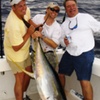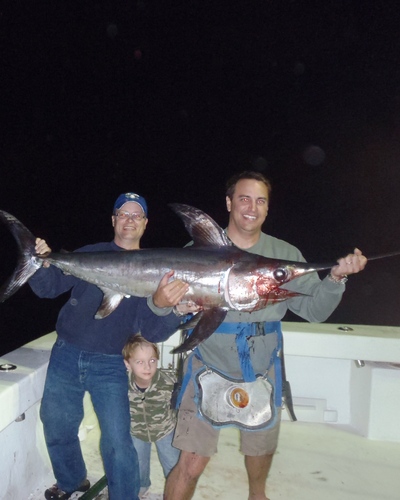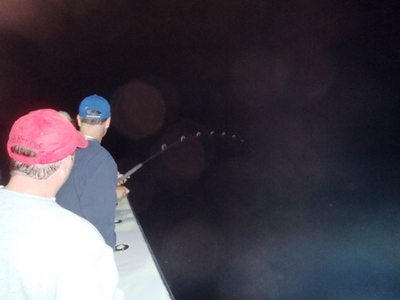Fishermen out of the Port of Orange Beach, Alabama, do battle with swordfish, named the gladiators of the seas, almost every month throughout the fall, spring and summer. One of the captains who take takes anglers out to battle these gladiators is Captain Johnny Greene of the charter boat "Intimidator." Here's Captain Greene's story.
We usually run 60-to 70-miles offshore and fish at night for swordfish, usually on a 2-day, offshore charter. If we're fishing on weekends during the special red snapper season being held through 12:01 am on November 22, we can catch and bring-in two limits of red snapper, grouper, amberjacks, triggerfish and vermilion snapper, as well as wahoo, marlin, tuna, dolphin and more. Last week we caught a swordfish almost as fast as we got our baits down.
To catch a swordfish, look for a bottom at about 1,000-feet deep or more and blue-green water where squid, blue runners and flying fish live and are easily attracted to light at night. We have underwater lights and also big spotlights on the tower of the "Intimidator."
Once we're setup we'll usually put-out two to five lines, depending on the current and the wind. On the last trip, because of the weather, we only could put-out two lines from 100- to 250-feet below the boat. We generally bait with an 8- to a 14-inch-long dead squid and use 15 feet of 300-pound-test line going from a barrel swivel to either a No. 7/0 or a No. 10/0 Mustad No. 7731 hook, or a traditional Mustad No. 39960 circle hook that's baited with the squid. Above the swivel, we attach a 6-inch light that has a chemical inside of a plastic tube that gives off light for 4- to 6-hours and then have 600 yards of 80-pound-test main line going to a Shimano Tiagra 50W LRS (Long-Range Special) Reel with an 80-class drag system.
To get the bait down to the depth where we want it, we use 32 ounces of lead. Then we attach 9 to 12 balloons with a 2-inch colored light stick inside each balloon to rubber bands to keep the bait suspended at the depth we want to fish. We place different colors of light sticks inside each balloon to know which line is attached to which rod. We use the same color electrician's tape to attach to the rod or the reel. Once we've identified which rod the swordfish is on, the angler can reel and take-up slack, leaving the rod still in the rod holder. Then the fisherman can feel the fish, which immediately will make a long run, pulling-off line at a rapid rate. Still leaving the rod in the rod holder, the angler puts on his stand-up fighting tackle and prepares to pick-up the rod and start working the fish into the boat, as soon as he slows down the swordfish's run. Fighting the fish like this helps to insure that you keep a tight line and bent rod to the swordfish at all times. Once you get the fish up to the boat, the deck hand will get the leader line, grab the fish's bill, pull the big swordfish into the boat and dispatch it. The swordfish we've been catching this fall in the Gulf of Mexico will weigh from about 80 to about 250 pounds.
When we return to the dock at Orange Beach Marina, we'll have a swordfish and a good catch of snapper, grouper, amberjacks and other fish. On a 2-day trip, I want my party to catch as many fish as they possibly can catch. We keep the fish we legally can keep and throw the rest back. The most-exciting part of the trip takes place at night when we catch the big swordfish.
To fish with Captain Johnny Greene on the "Intimidator" visit www.fishorangebeach.com, call 251-747-2872 or email him at fishorangebeach@gmail.com. You can learn more about other attractions available in Gulf Shores by calling Gulf Shores & Orange Beach Tourism at 800-745-SAND (7263), or by visiting www.orangebeach.com/fishing, where you also can get the weekly "What's Biting?" fishing report.
Sword fight in the Gulf of Mexico


A nice Alabama Swordfish

Hooked up to a Swordfish is exciting!

